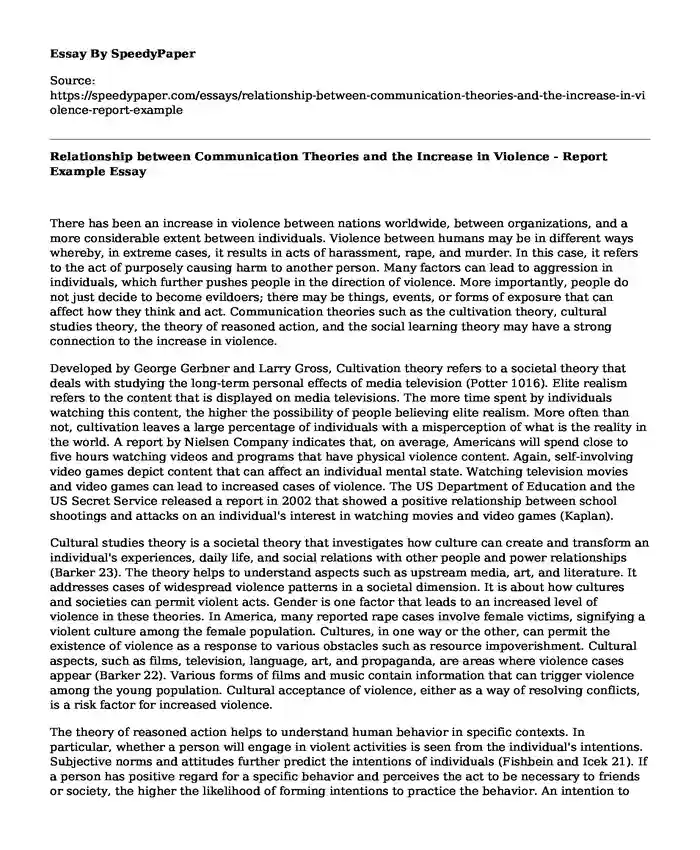There has been an increase in violence between nations worldwide, between organizations, and a more considerable extent between individuals. Violence between humans may be in different ways whereby, in extreme cases, it results in acts of harassment, rape, and murder. In this case, it refers to the act of purposely causing harm to another person. Many factors can lead to aggression in individuals, which further pushes people in the direction of violence. More importantly, people do not just decide to become evildoers; there may be things, events, or forms of exposure that can affect how they think and act. Communication theories such as the cultivation theory, cultural studies theory, the theory of reasoned action, and the social learning theory may have a strong connection to the increase in violence.
Developed by George Gerbner and Larry Gross, Cultivation theory refers to a societal theory that deals with studying the long-term personal effects of media television (Potter 1016). Elite realism refers to the content that is displayed on media televisions. The more time spent by individuals watching this content, the higher the possibility of people believing elite realism. More often than not, cultivation leaves a large percentage of individuals with a misperception of what is the reality in the world. A report by Nielsen Company indicates that, on average, Americans will spend close to five hours watching videos and programs that have physical violence content. Again, self-involving video games depict content that can affect an individual mental state. Watching television movies and video games can lead to increased cases of violence. The US Department of Education and the US Secret Service released a report in 2002 that showed a positive relationship between school shootings and attacks on an individual's interest in watching movies and video games (Kaplan).
Cultural studies theory is a societal theory that investigates how culture can create and transform an individual's experiences, daily life, and social relations with other people and power relationships (Barker 23). The theory helps to understand aspects such as upstream media, art, and literature. It addresses cases of widespread violence patterns in a societal dimension. It is about how cultures and societies can permit violent acts. Gender is one factor that leads to an increased level of violence in these theories. In America, many reported rape cases involve female victims, signifying a violent culture among the female population. Cultures, in one way or the other, can permit the existence of violence as a response to various obstacles such as resource impoverishment. Cultural aspects, such as films, television, language, art, and propaganda, are areas where violence cases appear (Barker 22). Various forms of films and music contain information that can trigger violence among the young population. Cultural acceptance of violence, either as a way of resolving conflicts, is a risk factor for increased violence.
The theory of reasoned action helps to understand human behavior in specific contexts. In particular, whether a person will engage in violent activities is seen from the individual's intentions. Subjective norms and attitudes further predict the intentions of individuals (Fishbein and Icek 21). If a person has positive regard for a specific behavior and perceives the act to be necessary to friends or society, the higher the likelihood of forming intentions to practice the behavior. An intention to engage in violent activities among individuals is a strong predictor of increased violent activities. An increase in violent cases, including rape and robberies, is on the rise because most people perform such activities with their feelings and not really because of an actual need (Fishbein and Icek 24). The theory, therefore, to a more considerable extent shows how individuals can practice violence due to their belief that individuals can execute their intentions whenever they are willing.
Social learning theory proposes that an individual can acquire new behaviors by observing and imitating other people (Bandura 3). Apart from observing the behaviors, a person can learn through observing rewards and punishments. Though an individual can commit a violent act by observing or learning from other people, the theory reinstates the importance of an individual's mental state. Individuals learn to exhibit aggressive behaviors that lead them to commit crimes by observing other aggressive people and observing how the behaviors are reinforced over time (Bandura 4). Young children in a society with violent activities will imitate the older aggressive adults they see in the social setting. An increase in violent activities is rampant in a society with aggressive behaviors; growing children will soon imitate what society has prepared for them.
Works Cited
Bandura, Albert. Social Learning Theory. Prentice Hall, 1977.
Barker, Chris. Cultural Studies: Theory and Practice. SAGE, 2016.
Fishbein, Martin, and Icek Ajzen. Predicting and Changing Behavior: The Reasoned Action Approach. Routledge, 2015.
Potter, W. James. "A Critical Analysis of Cultivation Theory." Journal of Communication, vol. 64, no. 6, 2014, pp. 1015–1036., doi:10.1111/jcom.12128.
Cite this page
Relationship between Communication Theories and the Increase in Violence - Report Example. (2024, Jan 19). Retrieved from https://speedypaper.com/essays/relationship-between-communication-theories-and-the-increase-in-violence-report-example
Request Removal
If you are the original author of this essay and no longer wish to have it published on the SpeedyPaper website, please click below to request its removal:
- Social Media Influence Essay Sample
- Free Essay Example on the Critical Class Room
- The Passion of the Christ - Movie Review Essay Sample
- Free Essay on The Gender Subjects' Attitudes and Perception Towards Physics
- Essay Example - The Benefits of the Socialist System to the State
- Disparities in Healthcare. Free Essay
- Community and Friendship Theme in 'Our Town' and 'Steel Magnolias' Movies - Essay Sample
Popular categories





